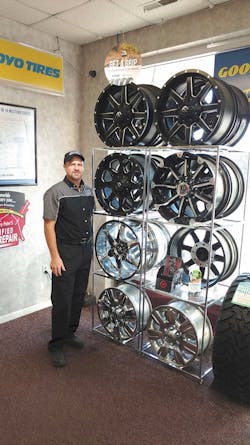Online selling has squeezed the profits out of custom wheel sales for Damon Nielson. To compensate for the tight margins, he and his sales staff bundle wheels, tires and lift kits into packages for their customers.
“The online sale of wheels has pretty much destroyed the market. The main reason we sell the wheels is to gain the package deal,” says Nielson, who owns T&C Tire Factory Inc., which does business as Tire Factory Point S.
The sale of lift kit, tire and wheel packages helps offset the longer selling process custom wheels require. The sales process for a set of tires can be five to 10 minutes. For wheels, it can take two to four hours. “If we lift the truck, we’re putting tires on it, we’re putting wheels on it and we’re doing the alignment. The overall package comes out to be a decent margin,” says Nielson.
Located in American Fork, Utah, Nielson’s shop provides retail and commercial tire sales and service, including 24-hour emergency road service for truck and bus fleets. He employs 12 technicians and four sales people.
10% of business
Drivers’ enthusiasm for spicing up their rides is why Nielson sells custom wheels, which make up about 10% of his business.
“Custom wheels are one of the few things people are excited about when they come into a shop. They get to dress up their car, they get to make it unique, and they get to make it their own. Custom wheels go hand-in-hand with tires and lift kits.”
Nielson’s typical custom wheel buyer is a 30- to 50-year-old man driving a 3/4-ton or 1-ton four-door diesel truck. “It’s someone who’s been in their career a bit and can afford a $50,000 to $70,000 truck. It’s their first baby, and they want to make it unique.”Nielson relies on same-day delivery from dealers in Salt Lake City, about 30 miles away. He sources from dealers who distribute MHT Wheel and Wheel Pros brands. “With the wide variety of styles, offsets, bolt patterns and finishes, it’s tough to stock the right wheel all the time so we lean on the warehouses.”
Fickle consumers are another reason to stock only a few wheels. “Every person’s taste is different. What we may think may be a hot mover doesn’t always fit the mold.”
Talk versus technology
Nielson and his staff avoid the virtual try-on technologies that allow a customer to use a computer or mobile device to visualize wheels on their vehicles. They tried the technology but customers felt their new wheels did not look like what they had seen on the computer screen.
Rather than rely on a software application, Nielson and his sales team ask customers questions. “Are they looking for a chrome wheel or an all-black wheel? We try to determine what kind of finish they want first. Second, we try to determine what diameter wheel they want, and what fitment as far as stock size or plus size. From there we talk about how they want the wheel to stand as far as offset.”
The next step is to go to suppliers’ websites for pictures of wheels. “We’ll print them out and show them. We try to limit what we are showing the customer to what’s available.”Nielson’s staff has completed the custom wheel sales and installer training offered by the Specialty Equipment Market Association. His technicians are certified in the Tire Industry Association’s Automotive Tire Service program.
The shop uses equipment from Hunter Engineering Co. Nielson says a balancer which provides a road force measurement is very important.
“You need to have state-of-the-art tire changers and balancers, and you need to have staff that is familiar with balancing custom rims. Vibration problems on a custom rim are much more prevalent than on an OE wheel, so you need to make sure you have the right equipment, right adapters, and properly trained and experienced staff.” ■
For more articles written by Ann Neal, click:




